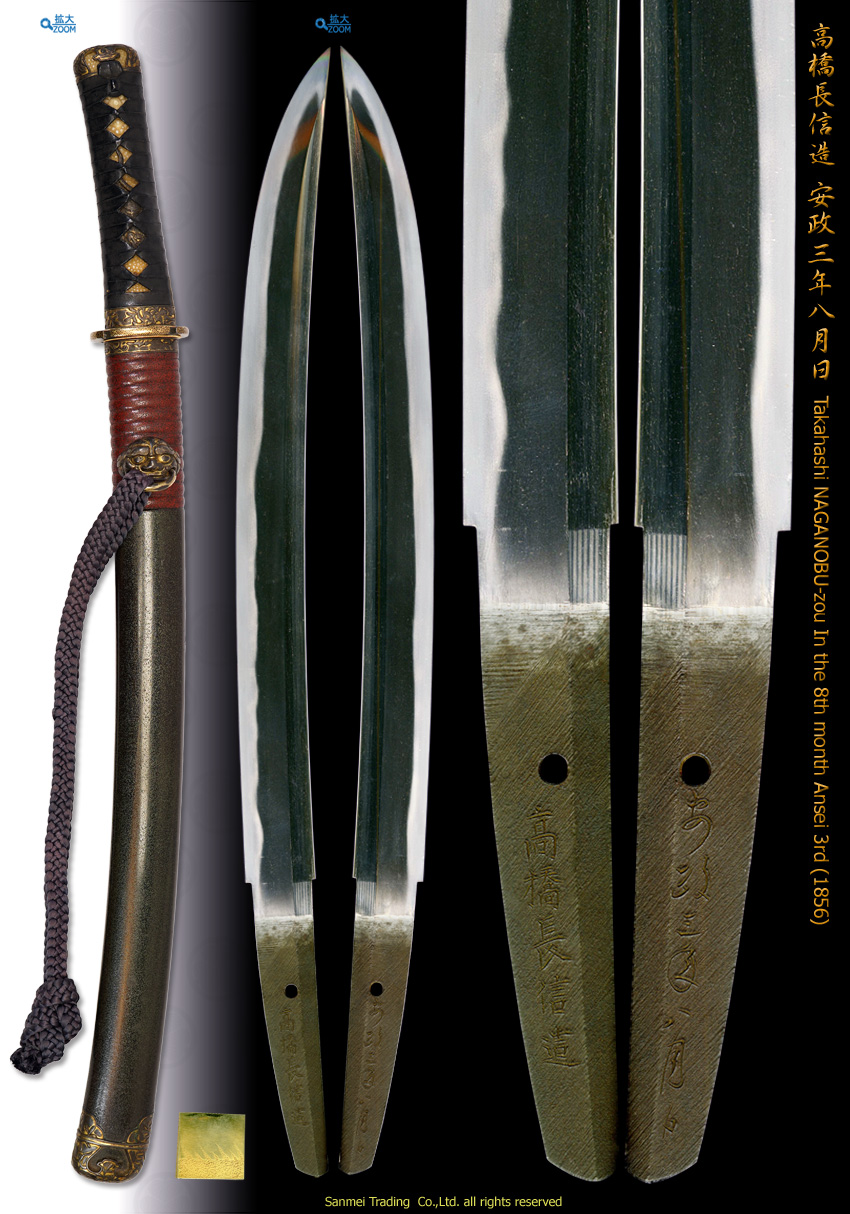with)Red and black separate coloring waist notches stone lacquered surface Koshigatana mount
Length of cutting edge 39.5cm Curvature 0.8cm Width of Base 33.7mm Thickness of base 7.5mm
Forging(Hada): Forging is minute Ko-Itame hada in general mixing with straight Masame ware that appears along quench side as well as Shinogi-ji surface. The Hiraji surface is covered with sparkling "Ji-nie" hard metal granules where generates darkish streaming lines of Chikei activity on Hiraji surface.
Temper(Hamon): Hamon is rather on stronger side Nie hard metal granules base, undulating "Notare" mixing with small Gunome and box-like Gunome. The interior is filled with extreme deep "Noi" mist-like crystalline area where thick Nie feet splashes onto the cutting edge. Long streaming Kinsuji or delicate lines of Sunagashi appears along bouondary line. In view of Shinogi-ji, there is isolated quenching sncene of "Yubashiri" and "Muneyaki". Those activities of quench state are extremely strikingly vivid and bright.
Temper of tip(Boshi): Boshi forms "Ko-maru" small circle with frequest Hakikake indication then gently turns back.
Tang(Nakago): Nakago is in UBU original, one peg hole. "Gyaku-sujikai" (greatly slanting right) filemarks with complex filemark in upper Suridashi area so called "Ko'tsutsumi". Back ridge of Nakago is a bit well-rounded contour with "Gyaku-sujikai" filemark. Bottom shape is single bevelled (Ha-agari-Kurijiri) in full. The signature in front is engraved on Hiraji, large chiselled inscription of Takahashi NAGANOBU-zou 高橋長信造 and the other side chiselled in cursive style with the date of year, In the 8th month, the 3rd year of Ansei (1856) 安政三年八月日.
One of the most famed sword smiths NAGANOBU 長信 ranks as Josaku (Superior made) masterpiece/O-wazamono (Above supreme sharp) cutting performance. He was born on the 18th day, 9th year of Bunka 14 (1817), in Sanbuichi town Izumo domain (now Hikawa-cho Sanbuichi, Izumo, Shimane-pref.) as the second son of farmer Sezaki Heisuke 瀬崎平助. His childhood name was Zenzo 善造, later named himself as Sezaki Rigei 瀬崎理兵衛.
On Bunsei 12 (1829) when he was 13 years old, he became a pupil of smith Konosuke FUYUHIRO 幸之助冬廣 of the 15th generation. Making swords turned into nature to him being adopted into FUYUHIRO 冬廣 family and worked his way up to the official sword maker of feudal lord Matsudaira Sadayasu 松平定安 of Matsue-han succeeding FUYUHIRO 冬廣 of the 17th generation.
On Tenpo 9 (1838), on the order of feudal lord, he moved up to Bushu Edo, now Tokyo to study under Cho-unsai TSUNATOSHI 長運齋綱俊 in two years and half, then became independent to establish his studio on about Tenpo 12 (1841) to change his smith name as Takahashi NAGANOBU 高橋長信.
It is said that he has poor hearing in his later age so some of his later works inscribes as "deaf NAGANOBU" or "Takahashi Hearing impaied-smith"
He was also one of the most distinguished makers who ranks an extraordinarily skillful maker with top ranking of the most supreme sharp cutting performance among all "Saijo O-waza-mono". He only chisels his own inscription on the sword with his own cutting performance test into the iron plate three times. The rumor went spread that famed smith KIYOMARO 清麿呂 took the sword from him before quenching then tempered it chiseled with his own inscription in order to meet with continuous orders with the top cutting performance quality standard.
He was very religious person to offer the extra large sized framed (300cm wide), double edged sword of Ken as long as 150cm on Ansei 3 (1856) which has been still hung in front of Komyoji hall in Naritasan Shorinji temple.
He was in the depth of despair and gave up sword making with an opportunity of the Sword Abolishment Edict in Meiji 9 (1876). Passed away on May 20, Meiji 12 (1879), was 63 years old.
The subject sword with great majesty was made on 1856 when he was matured, skilled in 40 years. He strongly looks up Soshu tradition in this work, especially ardently admired the work of Go-YOSHIHIRO 郷義弘. It is extra wide, making under special construction "Shobu-zukuri ". It was designed not only for stabber but also the most supreme sharp cutting through performance. Also Muneyaki stands on the defensive against hitting stroke..
Elaborate complex performed filemark of "Ko'tsutsumi" style and also cursive style date of year, both styles have close resemblances to the ones of Tsuda Echizen-no-kami SUKEHIRO津田越前守助広.
"Gyaku-sujikai" (greatly slanting right) filemarks shows that he was supposed left-handed.
This NAKABOBU comes with an original Koshirae of those days in excellent condition.
Red and black separate coloring waist notches stone lacquered surface Koshigatana mount
(click HERE for front / HERE for the reversed side of Koshirae and HERE for enlarged images of each fitting)
- All metal fittings (Fuchi/Kashira, Koikuchi, Ura-kawara and Kojiri) : Ivy arabesque design, Oborogin (silver/gold alloy) ground Sukibori carving, Gold Iroe, unsigned
- Menuki : Lion design Katabori carving, Gold Iroe
- Kurikata : Lion's mask design Katabori carving, Gold Iroe
- Tsuba : Oborogin (silver/gold alloy) ground, polish surface, Sayagata pattern gold Iroe, signed Buto (seal) at 77 years old
- Kozuka : Sword bean design, Oborogin ground, polish surface, Takabori carving, signed as YASUCHIKA 安親
- Tsuka : White rayskin, black lacquered leather lozenge wrap
Recent polish/Condition scale: mint - excellent (using a scale of mint-excellent-very good-good-fair-poor).
reference data :
Yasuhiro ABE, Researches of deaf sword smith Takahashi NAGANOBU in Unshu-domain, Kuroshio-sha, 1988




